Deck 2: A Users Guide to the Sky
سؤال
سؤال
سؤال
سؤال
سؤال
سؤال
سؤال
سؤال
سؤال
سؤال
سؤال
سؤال
سؤال
سؤال
سؤال
سؤال
سؤال
سؤال
سؤال
سؤال
سؤال
سؤال
سؤال
سؤال
سؤال
سؤال
سؤال
سؤال
سؤال
سؤال
سؤال
سؤال
سؤال
سؤال
سؤال
سؤال
سؤال
سؤال
سؤال
سؤال
سؤال
سؤال
سؤال
سؤال
سؤال
سؤال
سؤال
سؤال
سؤال
سؤال
سؤال
سؤال
سؤال
سؤال
سؤال
سؤال
سؤال
سؤال
سؤال
سؤال
سؤال
سؤال
سؤال
سؤال
سؤال
سؤال
سؤال
سؤال
سؤال
سؤال
سؤال
سؤال
سؤال
سؤال
سؤال
سؤال
سؤال
سؤال
سؤال
سؤال

فتح الحزمة
قم بالتسجيل لفتح البطاقات في هذه المجموعة!
Unlock Deck
Unlock Deck
1/116
العب
ملء الشاشة (f)
Deck 2: A Users Guide to the Sky
1
A(n) ____ is 1/60th of a degree.
A) precession
B) second of arc
C) minute of arc
D) nadir
E) angular diameter
A) precession
B) second of arc
C) minute of arc
D) nadir
E) angular diameter
C
2
An observer at Earth's geographic north pole would find _______
A) the celestial equator passing at 45 degrees above the northern horizon.
B) the celestial equator passing at 45 degrees above the southern horizon.
C) that the celestial equator coincides with the horizon.
D) the celestial equator passing directly overhead.
E) None of the other choices are true.
A) the celestial equator passing at 45 degrees above the northern horizon.
B) the celestial equator passing at 45 degrees above the southern horizon.
C) that the celestial equator coincides with the horizon.
D) the celestial equator passing directly overhead.
E) None of the other choices are true.
C
3
A(n) ____ is 1/60th of a minute of arc.
A) precession
B) second of arc
C) degree
D) nadir
E) angular diameter
A) precession
B) second of arc
C) degree
D) nadir
E) angular diameter
B
4
Constellation names are from _____ translated into _______, the language of science in Europe to the 19th century.
A) Greek; Latin
B) Latin; Greek
C) Latin; Arabic
D) Greek; English
E) Greek; Italian
A) Greek; Latin
B) Latin; Greek
C) Latin; Arabic
D) Greek; English
E) Greek; Italian

فتح الحزمة
افتح القفل للوصول البطاقات البالغ عددها 116 في هذه المجموعة.
فتح الحزمة
k this deck
5
The magnitude scale
A) originated just after the telescope was invented.
B) can be used to indicate the apparent intensity of a celestial object.
C) was devised by Galileo.
D) is no longer used today.
E) was used to determine the rate of precession.
A) originated just after the telescope was invented.
B) can be used to indicate the apparent intensity of a celestial object.
C) was devised by Galileo.
D) is no longer used today.
E) was used to determine the rate of precession.

فتح الحزمة
افتح القفل للوصول البطاقات البالغ عددها 116 في هذه المجموعة.
فتح الحزمة
k this deck
6
Most star names, such as Aldebaran and Betelgeuse, are___ in origin.
A) Latin
B) Greek
C) Arabic
D) English
E) Italian
A) Latin
B) Greek
C) Arabic
D) English
E) Italian

فتح الحزمة
افتح القفل للوصول البطاقات البالغ عددها 116 في هذه المجموعة.
فتح الحزمة
k this deck
7
The celestial equator is
A) a line around the sky directly above Earth's equator.
B) the dividing line between the north and south celestial hemispheres.
C) the path that the Sun appears to follow on the celestial sphere as Earth orbits the Sun.
D) a line around the sky directly above the Earth's equator and the dividing line between the north and south celestial hemispheres.
E) a line around the sky directly above Earth's equator and the dividing line between the north and south celestial hemispheres.
A) a line around the sky directly above Earth's equator.
B) the dividing line between the north and south celestial hemispheres.
C) the path that the Sun appears to follow on the celestial sphere as Earth orbits the Sun.
D) a line around the sky directly above the Earth's equator and the dividing line between the north and south celestial hemispheres.
E) a line around the sky directly above Earth's equator and the dividing line between the north and south celestial hemispheres.

فتح الحزمة
افتح القفل للوصول البطاقات البالغ عددها 116 في هذه المجموعة.
فتح الحزمة
k this deck
8
In contrast to Ursa Major, the Big Dipper is not a(n) ___ but is instead a(n) ______
A) star; constellation.
B) asterism; constellation.
C) a constellation; asterism.
D) Wrong! Both are asterisms.
E) Wrong! Both are official constellations.
A) star; constellation.
B) asterism; constellation.
C) a constellation; asterism.
D) Wrong! Both are asterisms.
E) Wrong! Both are official constellations.

فتح الحزمة
افتح القفل للوصول البطاقات البالغ عددها 116 في هذه المجموعة.
فتح الحزمة
k this deck
9
Seen from the northern latitudes (mid-northern hemisphere), the star Polaris
A) is never above the horizon during the day.
B) always sets directly in the west.
C) is always above the northern horizon.
D) is never visible during the winter.
E) is the brightest star in the sky.
A) is never above the horizon during the day.
B) always sets directly in the west.
C) is always above the northern horizon.
D) is never visible during the winter.
E) is the brightest star in the sky.

فتح الحزمة
افتح القفل للوصول البطاقات البالغ عددها 116 في هذه المجموعة.
فتح الحزمة
k this deck
10
An observer in the Northern Hemisphere watches the sky for several hours. Due to the motion of Earth, this observer notices that the stars near the north celestial pole appear to move
A) counter-clockwise around the celestial pole.
B) clockwise around the celestial pole.
C) from left to right.
D) from right to left.
E) nearly vertically upward.
A) counter-clockwise around the celestial pole.
B) clockwise around the celestial pole.
C) from left to right.
D) from right to left.
E) nearly vertically upward.

فتح الحزمة
افتح القفل للوصول البطاقات البالغ عددها 116 في هذه المجموعة.
فتح الحزمة
k this deck
11
An observer on Earth's equator would find _______
A) the celestial equator passing at 45 degrees above the northern horizon.
B) the celestial equator passing at 45 degrees above the southern horizon.
C) that the celestial equator coincides with the horizon.
D) the celestial equator passing directly overhead.
E) None of the other choices are true.
A) the celestial equator passing at 45 degrees above the northern horizon.
B) the celestial equator passing at 45 degrees above the southern horizon.
C) that the celestial equator coincides with the horizon.
D) the celestial equator passing directly overhead.
E) None of the other choices are true.

فتح الحزمة
افتح القفل للوصول البطاقات البالغ عددها 116 في هذه المجموعة.
فتح الحزمة
k this deck
12
An observer's nadir is
A) the point directly opposite the observer's zenith.
B) the north point on the observer's horizon.
C) located at the center of Earth.
D) always located near a circumpolar constellation.
E) directly opposite the north celestial pole.
A) the point directly opposite the observer's zenith.
B) the north point on the observer's horizon.
C) located at the center of Earth.
D) always located near a circumpolar constellation.
E) directly opposite the north celestial pole.

فتح الحزمة
افتح القفل للوصول البطاقات البالغ عددها 116 في هذه المجموعة.
فتح الحزمة
k this deck
13
Precession of the rotation axis of Earth is caused by
A) the force of gravity from the Sun and Moon on Earth's equatorial bulge.
B) the force of gravity from the Sun and Jupiter on the Earth-Moon system.
C) the magnetic field of Earth.
D) the formation and subsequent melting of glaciers during the ice-ages.
E) the impact of asteroids.
A) the force of gravity from the Sun and Moon on Earth's equatorial bulge.
B) the force of gravity from the Sun and Jupiter on the Earth-Moon system.
C) the magnetic field of Earth.
D) the formation and subsequent melting of glaciers during the ice-ages.
E) the impact of asteroids.

فتح الحزمة
افتح القفل للوصول البطاقات البالغ عددها 116 في هذه المجموعة.
فتح الحزمة
k this deck
14
The star Vega has an apparent visual magnitude of 0.03 and the star HR 4374 has an apparent visual magnitude of 4.87. It has been determined that both stars are at the same distance from Earth. What does this information tell us about the two stars?
A) Vega must be closer to Earth than HR 4374.
B) Vega must be farther from Earth than HR 4374.
C) Vega must produce less energy per second than HR 4374.
D) Vega must produce more energy per second than HR 4374.
E) Vega will appear fainter to us than HR 4374.
A) Vega must be closer to Earth than HR 4374.
B) Vega must be farther from Earth than HR 4374.
C) Vega must produce less energy per second than HR 4374.
D) Vega must produce more energy per second than HR 4374.
E) Vega will appear fainter to us than HR 4374.

فتح الحزمة
افتح القفل للوصول البطاقات البالغ عددها 116 في هذه المجموعة.
فتح الحزمة
k this deck
15
The ____ of an object can be measured in degrees.
A) apparent brightness
B) apparent magnitude
C) zenith
D) angular diameter
E) color
A) apparent brightness
B) apparent magnitude
C) zenith
D) angular diameter
E) color

فتح الحزمة
افتح القفل للوصول البطاقات البالغ عددها 116 في هذه المجموعة.
فتح الحزمة
k this deck
16
An observer on Earth's geographic north pole would find
A) Polaris directly overhead.
B) Polaris 40° above the northern horizon.
C) that the celestial equator coincides with the horizon.
D) celestial equator passing directly overhead.
E) that the ecliptic coincides with the horizon.
A) Polaris directly overhead.
B) Polaris 40° above the northern horizon.
C) that the celestial equator coincides with the horizon.
D) celestial equator passing directly overhead.
E) that the ecliptic coincides with the horizon.

فتح الحزمة
افتح القفل للوصول البطاقات البالغ عددها 116 في هذه المجموعة.
فتح الحزمة
k this deck
17
An observer on Earth's equator would find
A) Polaris directly overhead.
B) Polaris 40° above the northern horizon.
C) Polaris on the northern horizon.
D) the celestial equator passing directly overhead.
E) that the ecliptic coincides with the horizon.
A) Polaris directly overhead.
B) Polaris 40° above the northern horizon.
C) Polaris on the northern horizon.
D) the celestial equator passing directly overhead.
E) that the ecliptic coincides with the horizon.

فتح الحزمة
افتح القفل للوصول البطاقات البالغ عددها 116 في هذه المجموعة.
فتح الحزمة
k this deck
18
The apparent visual magnitude of a star is a measure of the star's
A) size.
B) intensity.
C) distance.
D) color.
E) temperature.
A) size.
B) intensity.
C) distance.
D) color.
E) temperature.

فتح الحزمة
افتح القفل للوصول البطاقات البالغ عددها 116 في هذه المجموعة.
فتح الحزمة
k this deck
19
The apparent visual magnitude of a star is 7.3. This tells us that the star is
A) one of the brighter stars in the sky.
B) bright enough that it would be visible even during the day.
C) not visible with the unaided eye.
D) very far from Earth.
E) very close to Earth.
A) one of the brighter stars in the sky.
B) bright enough that it would be visible even during the day.
C) not visible with the unaided eye.
D) very far from Earth.
E) very close to Earth.

فتح الحزمة
افتح القفل للوصول البطاقات البالغ عددها 116 في هذه المجموعة.
فتح الحزمة
k this deck
20
The ____ is the point on the celestial sphere directly above an observer who can be at any point on the Earth.
A) north celestial pole
B) south celestial pole
C) zenith
D) celestial equator
E) nadir
A) north celestial pole
B) south celestial pole
C) zenith
D) celestial equator
E) nadir

فتح الحزمة
افتح القفل للوصول البطاقات البالغ عددها 116 في هذه المجموعة.
فتح الحزمة
k this deck
21
An observer in the Southern Hemisphere takes a time exposure photograph of the night sky. If the illustration below depicts the photograph taken by the observer, which direction was the camera pointing? 
A) straight north
B) straight east
C) straight south
D) straight west
E) straight up, directly overhead

A) straight north
B) straight east
C) straight south
D) straight west
E) straight up, directly overhead

فتح الحزمة
افتح القفل للوصول البطاقات البالغ عددها 116 في هذه المجموعة.
فتح الحزمة
k this deck
22
An observer in the Northern Hemisphere takes a time exposure photograph of the night sky. If the illustration below depicts the photograph taken by the observer, which direction was the camera pointing? 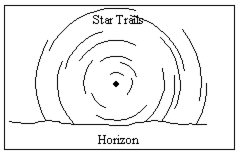
A) straight north
B) straight east
C) straight south
D) straight west
E) straight up, directly overhead

A) straight north
B) straight east
C) straight south
D) straight west
E) straight up, directly overhead

فتح الحزمة
افتح القفل للوصول البطاقات البالغ عددها 116 في هذه المجموعة.
فتح الحزمة
k this deck
23
What is the approximate latitude of the observer in the diagram below if they are located in the hemisphere containing the south celestial pole?

A) 20° N
B) 20° S
C) 70° N
D) 70° S
E) 0°

A) 20° N
B) 20° S
C) 70° N
D) 70° S
E) 0°

فتح الحزمة
افتح القفل للوصول البطاقات البالغ عددها 116 في هذه المجموعة.
فتح الحزمة
k this deck
24
If the north celestial pole appears on your horizon, what is your latitude?
A) 90° N
B) 90° S
C) 0°
D) 45° N
E) The latitude of the observer cannot be determined from the information given.
A) 90° N
B) 90° S
C) 0°
D) 45° N
E) The latitude of the observer cannot be determined from the information given.

فتح الحزمة
افتح القفل للوصول البطاقات البالغ عددها 116 في هذه المجموعة.
فتح الحزمة
k this deck
25
An observer in the Southern Hemisphere takes a time exposure photograph of the night sky. If the illustration below depicts the photograph taken by the observer, which direction was the camera pointing? 
A) straight north
B) straight east
C) straight south
D) straight west
E) straight up, directly overhead

A) straight north
B) straight east
C) straight south
D) straight west
E) straight up, directly overhead

فتح الحزمة
افتح القفل للوصول البطاقات البالغ عددها 116 في هذه المجموعة.
فتح الحزمة
k this deck
26
Table 2-1  Refer to Table 2-1. Based on the information in the table, what is the ratio of the intensity of Dra to that of Nim?
Refer to Table 2-1. Based on the information in the table, what is the ratio of the intensity of Dra to that of Nim?
A) 2.512
B) 5
C) 8.07
D) 11.14
E) 100
 Refer to Table 2-1. Based on the information in the table, what is the ratio of the intensity of Dra to that of Nim?
Refer to Table 2-1. Based on the information in the table, what is the ratio of the intensity of Dra to that of Nim?A) 2.512
B) 5
C) 8.07
D) 11.14
E) 100

فتح الحزمة
افتح القفل للوصول البطاقات البالغ عددها 116 في هذه المجموعة.
فتح الحزمة
k this deck
27
Table 2-1 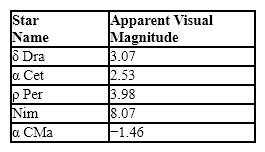 Refer to Table 2-1. Which star in the table would appear the brightest to an observer on Earth?
Refer to Table 2-1. Which star in the table would appear the brightest to an observer on Earth?
A) α Cet
B) α CMa
C) Nim
D) ρ Per
E) δ Dra
 Refer to Table 2-1. Which star in the table would appear the brightest to an observer on Earth?
Refer to Table 2-1. Which star in the table would appear the brightest to an observer on Earth?A) α Cet
B) α CMa
C) Nim
D) ρ Per
E) δ Dra

فتح الحزمة
افتح القفل للوصول البطاقات البالغ عددها 116 في هذه المجموعة.
فتح الحزمة
k this deck
28
Do the constellations visible in the sky at a particular time of night (say 9 P.M.) follow a seasonal pattern?
A) No, the same constellations are visible at 9 P.M. on any clear night of the year.
B) No. As the year progresses, the constellations visible at 9 P.M. are the same but their shapes change.
C) Yes, at 9 P.M. during a clear winter night ALL of the constellations you can see are different from the ones that appear at the same time during a summer night.
D) Yes, at 9 P.M. during a summer night most of the constellations you can see are different from those you can see on a winter night. However, there are some constellations that are visible all year long.
A) No, the same constellations are visible at 9 P.M. on any clear night of the year.
B) No. As the year progresses, the constellations visible at 9 P.M. are the same but their shapes change.
C) Yes, at 9 P.M. during a clear winter night ALL of the constellations you can see are different from the ones that appear at the same time during a summer night.
D) Yes, at 9 P.M. during a summer night most of the constellations you can see are different from those you can see on a winter night. However, there are some constellations that are visible all year long.

فتح الحزمة
افتح القفل للوصول البطاقات البالغ عددها 116 في هذه المجموعة.
فتح الحزمة
k this deck
29
You live at a latitude of 16° S. What is the angle between the southern horizon and the south celestial pole?
A) 74°
B) 164°
C) 16°
D) 23.4°
E) 5°
A) 74°
B) 164°
C) 16°
D) 23.4°
E) 5°

فتح الحزمة
افتح القفل للوصول البطاقات البالغ عددها 116 في هذه المجموعة.
فتح الحزمة
k this deck
30
You live at a latitude of 39° S. What is the angle between the southern horizon and the south celestial pole?
A) 45°
B) 23.4°
C) 39°
D) 51°
E) The answer depends on the day of the year.
A) 45°
B) 23.4°
C) 39°
D) 51°
E) The answer depends on the day of the year.

فتح الحزمة
افتح القفل للوصول البطاقات البالغ عددها 116 في هذه المجموعة.
فتح الحزمة
k this deck
31
You live at a latitude of 28° N. What is the angle between the northern horizon and the north celestial pole?
A) 62°
B) 28°
C) 40°
D) 23.4°
E) 5°
A) 62°
B) 28°
C) 40°
D) 23.4°
E) 5°

فتح الحزمة
افتح القفل للوصول البطاقات البالغ عددها 116 في هذه المجموعة.
فتح الحزمة
k this deck
32
You live at a latitude of 39° S. What is the angle between the southern horizon and the south celestial pole?
A) 45°
B) 23.4°
C) 39°
D) 51°
E) The answer depends on the day of the year.
A) 45°
B) 23.4°
C) 39°
D) 51°
E) The answer depends on the day of the year.

فتح الحزمة
افتح القفل للوصول البطاقات البالغ عددها 116 في هذه المجموعة.
فتح الحزمة
k this deck
33
You live at a latitude of 73° N. What is the angle between the northern horizon and the north celestial pole?
A) 73°
B) 27°
C) 17°
D) 23.4°
E) 5°
A) 73°
B) 27°
C) 17°
D) 23.4°
E) 5°

فتح الحزمة
افتح القفل للوصول البطاقات البالغ عددها 116 في هذه المجموعة.
فتح الحزمة
k this deck
34
An observer in the Northern Hemisphere takes a time exposure photograph of the night sky. If the illustration below depicts the photograph taken by the observer, which direction was the camera pointing? 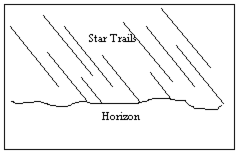
A) straight north
B) straight east
C) straight south
D) straight west
E) straight up, directly overhead

A) straight north
B) straight east
C) straight south
D) straight west
E) straight up, directly overhead

فتح الحزمة
افتح القفل للوصول البطاقات البالغ عددها 116 في هذه المجموعة.
فتح الحزمة
k this deck
35
Polaris is a second magnitude star, and Phi Pegasi is about 16 times fainter than Polaris. What is the approximate magnitude of Phi Pegasi?
A) 18
B) − 14
C) 3
D) − 3
E) 5
A) 18
B) − 14
C) 3
D) − 3
E) 5

فتح الحزمة
افتح القفل للوصول البطاقات البالغ عددها 116 في هذه المجموعة.
فتح الحزمة
k this deck
36
Star A has an apparent visual magnitude of 13.4 and star B has an apparent visual magnitude of 15.4. Star A is ____ than star B.
A) 2 times fainter
B) 2 times brighter
C) 6.3 times fainter
D) 6.3 times brighter
E) 29.8 times fainter
A) 2 times fainter
B) 2 times brighter
C) 6.3 times fainter
D) 6.3 times brighter
E) 29.8 times fainter

فتح الحزمة
افتح القفل للوصول البطاقات البالغ عددها 116 في هذه المجموعة.
فتح الحزمة
k this deck
37
What is the approximate latitude of the observer in the diagram below if they are located in the hemisphere containing the north celestial pole?

A) 90° N
B) 90° S
C) 50° N
D) 50° S
E) 0°

A) 90° N
B) 90° S
C) 50° N
D) 50° S
E) 0°

فتح الحزمة
افتح القفل للوصول البطاقات البالغ عددها 116 في هذه المجموعة.
فتح الحزمة
k this deck
38
Table 2-1 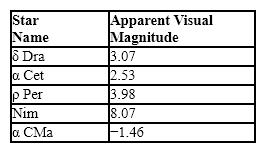 Refer to Table 2-1. Which star in the table would not be visible to the unaided eye of an observer on Earth?
Refer to Table 2-1. Which star in the table would not be visible to the unaided eye of an observer on Earth?
A) α Cet
B) α Cma
C) Nim
D) ρ Per
E) δ Dra
 Refer to Table 2-1. Which star in the table would not be visible to the unaided eye of an observer on Earth?
Refer to Table 2-1. Which star in the table would not be visible to the unaided eye of an observer on Earth?A) α Cet
B) α Cma
C) Nim
D) ρ Per
E) δ Dra

فتح الحزمة
افتح القفل للوصول البطاقات البالغ عددها 116 في هذه المجموعة.
فتح الحزمة
k this deck
39
An observer in the Northern Hemisphere takes a time exposure photograph of the night sky. If the illustration below depicts the photograph taken by the observer, which direction was the camera pointing? 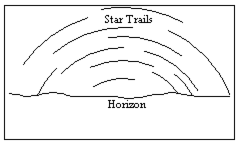
A) straight north
B) straight east
C) straight south
D) straight west
E) straight up, directly overhead

A) straight north
B) straight east
C) straight south
D) straight west
E) straight up, directly overhead

فتح الحزمة
افتح القفل للوصول البطاقات البالغ عددها 116 في هذه المجموعة.
فتح الحزمة
k this deck
40
An observer in the Southern Hemisphere takes a time exposure photograph of the night sky. If the illustration below depicts the photograph taken by the observer, which direction was the camera pointing? 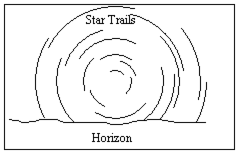
A) straight north
B) straight east
C) straight south
D) straight west
E) straight up, directly overhead

A) straight north
B) straight east
C) straight south
D) straight west
E) straight up, directly overhead

فتح الحزمة
افتح القفل للوصول البطاقات البالغ عددها 116 في هذه المجموعة.
فتح الحزمة
k this deck
41
Precession of the rotation axis of Earth takes ____ to complete a cycle.
A) 24 hours
B) one year
C) 260 years
D) 26,000 years
E) 260,000 years
A) 24 hours
B) one year
C) 260 years
D) 26,000 years
E) 260,000 years

فتح الحزمة
افتح القفل للوصول البطاقات البالغ عددها 116 في هذه المجموعة.
فتح الحزمة
k this deck
42
Which of the following is ordered correctly from smallest to largest?
A) arc minute, arc second, degree
B) degree, arc minute, arc second
C) arc minute, degree, arc second
D) arc second, arc minute, degree
A) arc minute, arc second, degree
B) degree, arc minute, arc second
C) arc minute, degree, arc second
D) arc second, arc minute, degree

فتح الحزمة
افتح القفل للوصول البطاقات البالغ عددها 116 في هذه المجموعة.
فتح الحزمة
k this deck
43
Which of the following is false?
A) Alpha Orionis is apparently brighter than Beta Orionis.
B) Beta Orionis is apparently brighter than Alpha Orionis.
C) Rigel is apparently brighter than Betelgeuse.
D) None of the choices are false.
A) Alpha Orionis is apparently brighter than Beta Orionis.
B) Beta Orionis is apparently brighter than Alpha Orionis.
C) Rigel is apparently brighter than Betelgeuse.
D) None of the choices are false.

فتح الحزمة
افتح القفل للوصول البطاقات البالغ عددها 116 في هذه المجموعة.
فتح الحزمة
k this deck
44
A star is given a designation of Alpha Draconis and thus apparently it is the _______________ in the constellation.
A) brightest
B) second brightest
C) third brightest
D) fourth brightest
A) brightest
B) second brightest
C) third brightest
D) fourth brightest

فتح الحزمة
افتح القفل للوصول البطاقات البالغ عددها 116 في هذه المجموعة.
فتح الحزمة
k this deck
45
In one way of naming stars, a(n) ____ letter indicates its brightness relative to the other stars in the constellation.
A) English
B) Arabic
C) Greek
D) Cyrillic
A) English
B) Arabic
C) Greek
D) Cyrillic

فتح الحزمة
افتح القفل للوصول البطاقات البالغ عددها 116 في هذه المجموعة.
فتح الحزمة
k this deck
46
As seen from the Earth's southern hemisphere, the celestial equator passes
A) north of overhead.
B) south of overhead.
C) through the north celestial pole.
D) through the south celestial pole.
A) north of overhead.
B) south of overhead.
C) through the north celestial pole.
D) through the south celestial pole.

فتح الحزمة
افتح القفل للوصول البطاقات البالغ عددها 116 في هذه المجموعة.
فتح الحزمة
k this deck
47
If you were standing on the Earth's equator, which of the following in the sky would pass through your zenith during the entire day (24 hours)?
A) the north celestial pole
B) the south celestial pole
C) the celestial equator
D) the nadir
A) the north celestial pole
B) the south celestial pole
C) the celestial equator
D) the nadir

فتح الحزمة
افتح القفل للوصول البطاقات البالغ عددها 116 في هذه المجموعة.
فتح الحزمة
k this deck
48
Stars in the same constellation
A) probably formed at the same time.
B) must be part of the same cluster of stars in space.
C) must have been discovered at about the same time at the same location in space.
D) may actually be very different distances away from the observer and from each other.
A) probably formed at the same time.
B) must be part of the same cluster of stars in space.
C) must have been discovered at about the same time at the same location in space.
D) may actually be very different distances away from the observer and from each other.

فتح الحزمة
افتح القفل للوصول البطاقات البالغ عددها 116 في هذه المجموعة.
فتح الحزمة
k this deck
49
During the month of June the north celestial pole points towards Polaris, but during the month of December it points
A) just north of Polaris.
B) just south of Polaris.
C) towards the star Vega.
D) towards the star Thuban.
E) still towards Polaris.
A) just north of Polaris.
B) just south of Polaris.
C) towards the star Vega.
D) towards the star Thuban.
E) still towards Polaris.

فتح الحزمة
افتح القفل للوصول البطاقات البالغ عددها 116 في هذه المجموعة.
فتح الحزمة
k this deck
50
____ is the brightest star in the constellation of Ursa Majoris.
A) β Ursa Majoris
B) γ Ursa Majoris
C) α Ursa Majoris
D) Wrong! Ursa Majoris is the name of the brightest star.
A) β Ursa Majoris
B) γ Ursa Majoris
C) α Ursa Majoris
D) Wrong! Ursa Majoris is the name of the brightest star.

فتح الحزمة
افتح القفل للوصول البطاقات البالغ عددها 116 في هذه المجموعة.
فتح الحزمة
k this deck
51
If an observer walks north toward increasing latitude, the number of circumpolar stars would
A) remain constant.
B) decrease.
C) increase.
D) Unknown unless you also state the longitude of the observer.
A) remain constant.
B) decrease.
C) increase.
D) Unknown unless you also state the longitude of the observer.

فتح الحزمة
افتح القفل للوصول البطاقات البالغ عددها 116 في هذه المجموعة.
فتح الحزمة
k this deck
52
During one day and night in the mid-northern hemisphere, the stars near the north celestial pole
A) rise in the east.
B) set in the west.
C) circle the north celestial pole counter-clockwise.
D) circle the north celestial pole clockwise.
A) rise in the east.
B) set in the west.
C) circle the north celestial pole counter-clockwise.
D) circle the north celestial pole clockwise.

فتح الحزمة
افتح القفل للوصول البطاقات البالغ عددها 116 في هذه المجموعة.
فتح الحزمة
k this deck
53
How much of the Earth's surface is experiencing night at any time?
A) less than one-half, because of the tilt of the equator to the ecliptic plane
B) more than one-half, because of the precession of the poles
C) exactly one-half
D) all of the night sky
A) less than one-half, because of the tilt of the equator to the ecliptic plane
B) more than one-half, because of the precession of the poles
C) exactly one-half
D) all of the night sky

فتح الحزمة
افتح القفل للوصول البطاقات البالغ عددها 116 في هذه المجموعة.
فتح الحزمة
k this deck
54
How much of the sky is north of the celestial equator?
A) less than one-half, because of the tilt of the equator to the ecliptic plane
B) more than one-half, because of the precession of the poles
C) exactly one-half
D) all of the night sky
A) less than one-half, because of the tilt of the equator to the ecliptic plane
B) more than one-half, because of the precession of the poles
C) exactly one-half
D) all of the night sky

فتح الحزمة
افتح القفل للوصول البطاقات البالغ عددها 116 في هذه المجموعة.
فتح الحزمة
k this deck
55
If you point toward the zenith right now and then point there again 6 hours later, you will have pointed twice in the same direction relative to
A) your horizon.
B) the Sun.
C) the Moon.
D) the fixed stars.
A) your horizon.
B) the Sun.
C) the Moon.
D) the fixed stars.

فتح الحزمة
افتح القفل للوصول البطاقات البالغ عددها 116 في هذه المجموعة.
فتح الحزمة
k this deck
56
A sketch of the Earth with its north and south poles and equator is shown. The zenith is located in the sky over your head if you are at 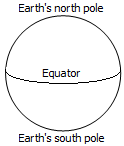
A) Earth's equator.
B) Earth's north pole.
C) Earth's south pole.
D) any of these.

A) Earth's equator.
B) Earth's north pole.
C) Earth's south pole.
D) any of these.

فتح الحزمة
افتح القفل للوصول البطاقات البالغ عددها 116 في هذه المجموعة.
فتح الحزمة
k this deck
57
If you are standing at the Earth's north pole, which of the following would be located at the zenith?
A) the nadir
B) the star Vega
C) the celestial equator
D) the north celestial pole
A) the nadir
B) the star Vega
C) the celestial equator
D) the north celestial pole

فتح الحزمة
افتح القفل للوصول البطاقات البالغ عددها 116 في هذه المجموعة.
فتح الحزمة
k this deck
58
Seen from the northern latitudes, the star Polaris
A) is never above the horizon during the day.
B) always sets directly in the west.
C) is always above the northern horizon.
D) is never visible during the winter.
E) is the brightest star in the sky.
A) is never above the horizon during the day.
B) always sets directly in the west.
C) is always above the northern horizon.
D) is never visible during the winter.
E) is the brightest star in the sky.

فتح الحزمة
افتح القفل للوصول البطاقات البالغ عددها 116 في هذه المجموعة.
فتح الحزمة
k this deck
59
Which of the following statements correctly describes the relationship between stars and constellations?
A) Only stars close to the ecliptic (the Earth's orbital plane) are located in constellations.
B) Every star is located in a constellation.
C) Only the brighter stars are in constellations.
D) Only those stars that were visible to the ancient Greeks are located in constellations.
A) Only stars close to the ecliptic (the Earth's orbital plane) are located in constellations.
B) Every star is located in a constellation.
C) Only the brighter stars are in constellations.
D) Only those stars that were visible to the ancient Greeks are located in constellations.

فتح الحزمة
افتح القفل للوصول البطاقات البالغ عددها 116 في هذه المجموعة.
فتح الحزمة
k this deck
60
At the Earth's north pole, the north celestial pole is directly overhead and stars near the horizon travel in straight lines
A) straight up from the horizon.
B) straight up from the horizon slanting toward the right.
C) straight up from the horizon slanting toward the left.
D) parallel to the horizon.
A) straight up from the horizon.
B) straight up from the horizon slanting toward the right.
C) straight up from the horizon slanting toward the left.
D) parallel to the horizon.

فتح الحزمة
افتح القفل للوصول البطاقات البالغ عددها 116 في هذه المجموعة.
فتح الحزمة
k this deck
61
Less formally defined groupings of stars are called __________________.

فتح الحزمة
افتح القفل للوصول البطاقات البالغ عددها 116 في هذه المجموعة.
فتح الحزمة
k this deck
62
In which direction is Earth precessing? Choose the best answer.
A) towards Polaris
B) towards Thuban
C) away from Polaris
D) away from Sirius
A) towards Polaris
B) towards Thuban
C) away from Polaris
D) away from Sirius

فتح الحزمة
افتح القفل للوصول البطاقات البالغ عددها 116 في هذه المجموعة.
فتح الحزمة
k this deck
63
Earth's rotation axis traces out a cone shape in the sky, precessing in the ___________________ direction.

فتح الحزمة
افتح القفل للوصول البطاقات البالغ عددها 116 في هذه المجموعة.
فتح الحزمة
k this deck
64
_________ is equal to the angular distance from the horizon to the north celestial pole.

فتح الحزمة
افتح القفل للوصول البطاقات البالغ عددها 116 في هذه المجموعة.
فتح الحزمة
k this deck
65
The approximate intensity ratio between two stars is 100. Thus the apparent visual magnitude difference between the stars is ______________.
A) 1
B) 5
C) 10
D) 100
A) 1
B) 5
C) 10
D) 100

فتح الحزمة
افتح القفل للوصول البطاقات البالغ عددها 116 في هذه المجموعة.
فتح الحزمة
k this deck
66
The light from Polaris is 24.2 times less intense than the light received from Sirius. Which star is the truly brighter star, that is, emitting more visual light at its surface?
A) Polaris
B) Sirius
C) Neither, they emit the same amount at their surfaces.
D) This cannot be determined based upon the information given.
A) Polaris
B) Sirius
C) Neither, they emit the same amount at their surfaces.
D) This cannot be determined based upon the information given.

فتح الحزمة
افتح القفل للوصول البطاقات البالغ عددها 116 في هذه المجموعة.
فتح الحزمة
k this deck
67

In the picture shown, the lines are called __________________.

فتح الحزمة
افتح القفل للوصول البطاقات البالغ عددها 116 في هذه المجموعة.
فتح الحزمة
k this deck
68
A star has an apparent visual magnitude of +19. Which will you need to see this star?
A) naked eye
B) binoculars
C) telescope like Hubble Space Telescope
D) All of the other choices can be used.
A) naked eye
B) binoculars
C) telescope like Hubble Space Telescope
D) All of the other choices can be used.

فتح الحزمة
افتح القفل للوصول البطاقات البالغ عددها 116 في هذه المجموعة.
فتح الحزمة
k this deck
69
On a clear night you go outside and face south and see circumpolar stars. Then you turn and face north and you see stars rising in the east and setting in the west. Where are you located on Earth?
A) equator
B) a mid-latitude between the equator and the north pole
C) south pole
D) a mid-latitude between the equator and the south pole
A) equator
B) a mid-latitude between the equator and the north pole
C) south pole
D) a mid-latitude between the equator and the south pole

فتح الحزمة
افتح القفل للوصول البطاقات البالغ عددها 116 في هذه المجموعة.
فتح الحزمة
k this deck
70

In the picture shown, which label is the asterism, constellation, and star?
A) Little Dipper is the constellation, no asterism is labeled, and Polaris is the star.
B) Big Dipper is the asterism, no star is labeled, and Polaris is the constellation.
C) Polaris is the star, Little Dipper is the asterism, and no constellation is labeled.
D) No star or asterism is labeled but Big Dipper is the constellation name.

فتح الحزمة
افتح القفل للوصول البطاقات البالغ عددها 116 في هذه المجموعة.
فتح الحزمة
k this deck
71
In the designation α Canis Majoris, which part refers to the star and which part refers to the constellation?
A) α refers to the constellation and Canis Majoris refers to the star.
B) α Canis Majoris refers to the star whereas Canis Majoris refes to the constellation.
C) α Canis refers to the star whereas Majoris refers to the constellation.
D) None of the other choices are correct.
A) α refers to the constellation and Canis Majoris refers to the star.
B) α Canis Majoris refers to the star whereas Canis Majoris refes to the constellation.
C) α Canis refers to the star whereas Majoris refers to the constellation.
D) None of the other choices are correct.

فتح الحزمة
افتح القفل للوصول البطاقات البالغ عددها 116 في هذه المجموعة.
فتح الحزمة
k this deck
72
The ____________________ is the point on the celestial sphere directly above an observer, regardless of where the observer is located on Earth.

فتح الحزمة
افتح القفل للوصول البطاقات البالغ عددها 116 في هذه المجموعة.
فتح الحزمة
k this deck
73
The subscript ______ stands for ________ to remind you that only information on visible light is given.

فتح الحزمة
افتح القفل للوصول البطاقات البالغ عددها 116 في هذه المجموعة.
فتح الحزمة
k this deck
74
____________________ is a measure of the light energy that hits one square meter in one second.

فتح الحزمة
افتح القفل للوصول البطاقات البالغ عددها 116 في هذه المجموعة.
فتح الحزمة
k this deck
75
Earth's rotation axis ____________________ slowly so that in a few thousand years Polaris will no longer be the North Star.

فتح الحزمة
افتح القفل للوصول البطاقات البالغ عددها 116 في هذه المجموعة.
فتح الحزمة
k this deck
76
Star A has an apparent visual magnitude of 6.3 and star B has an apparent visual magnitude of 5.3. Star A is _________ times (fainter or brighter) than star B.

فتح الحزمة
افتح القفل للوصول البطاقات البالغ عددها 116 في هذه المجموعة.
فتح الحزمة
k this deck
77
North, south, east, and west are points on the _____________ of your local sky.

فتح الحزمة
افتح القفل للوصول البطاقات البالغ عددها 116 في هذه المجموعة.
فتح الحزمة
k this deck
78
Which of the following is an example of a scientific model?
A) celestial sphere
B) connected balls and rods representing chemical bonds of a DNA molecule
C) topographical map
D) All of the other choices are correct.
A) celestial sphere
B) connected balls and rods representing chemical bonds of a DNA molecule
C) topographical map
D) All of the other choices are correct.

فتح الحزمة
افتح القفل للوصول البطاقات البالغ عددها 116 في هذه المجموعة.
فتح الحزمة
k this deck
79
You stand at attention with your arm overhead and finger pointing to the sky for 12 hours. During this entire time, your finger traces along the celestial equator in the sky. Where are you located on Earth?
A) North Pole
B) South Pole
C) equator
D) mid-latitude between the equator and the North Pole
A) North Pole
B) South Pole
C) equator
D) mid-latitude between the equator and the North Pole

فتح الحزمة
افتح القفل للوصول البطاقات البالغ عددها 116 في هذه المجموعة.
فتح الحزمة
k this deck
80
Which can be seen by the naked eye?
A) m v = +10
B) m v = +18
C) m v = +6
D) m v = +8
A) m v = +10
B) m v = +18
C) m v = +6
D) m v = +8

فتح الحزمة
افتح القفل للوصول البطاقات البالغ عددها 116 في هذه المجموعة.
فتح الحزمة
k this deck








